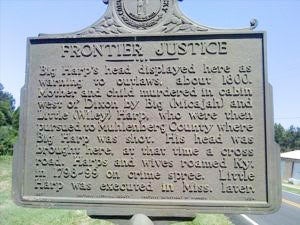The Murdering Harpes: Part 2
Published 10:51 am Friday, April 21, 2023
BY JADON GIBSON
Contributing Writer
It was less than 50 years after Dr. Thomas Walker documented the discovery of Cumberland Gap in 1750 when the Harpe brothers spread their misery and mayhem along the trails of early America. It was less than a quarter century after Daniel Boone led his band of 30 men blazing the trails from Sycamore Shoals (Elizabethton) to the Kentucky River. It opened the floodgates to pioneers along the Wilderness Road.
Early Americans found it hazardous to trek through the area because Indians disdained relinquishing the land where their forefathers had lived and hunted for centuries. There were also individuals like the Harpes who went westward to escape from the law, to evade prosecution.
A cavalcade of wagons and horsemen discovered a body along the Wilderness Road near the young settlement of Barbourville in 1797 after noticing a flock of buzzards circling above. The dead man was a peddler along the early trails as he was found with his grip nearby, void of its contents. He had been tomahawked and covered with brush in order to avoid early detection.
Word was spreading about the dreaded Harpes along the trails and settlements.
Rev. Lambuth had been robbed by the Harpes and warned everyone he could but mass communication wasn’t available in that period. Information was disseminated mostly by the spoken word. Written words (newspapers) were rare and slow in arriving.
The Harpes were staying on the move to lessen the likelihood of being caught. They were aware of the basic tenets in thievery and mischief. As nightfall descended they came upon Hughes Tavern along the Holston River, not far from Knoxville. It had a reputation as a “rough groggery.”
Men went to bed and rose with the chickens in that era and Hughes locked his door behind his last patron, a man named Johnson.
The Harpes came upon Johnson soon after he left Hughes Tavern. Two or three days later his disemboweled body was found floating in the Holston River. Rocks had been placed in his stomach but enough spilled out, and the body had enough buoyancy that allowed it to be seen from the shore. By this time the Harpes were long-gone.
The tavern-keeper and two others were arrested for the murder but were released due to lack of evidence. Hughes reopened his “groggery” but a vigilante group of citizen “regulators” called on him and gave him a lashing with a leather whip. They then destroyed his building and admonished him to “leave the territory and not return.”
A few days later two men were found dead on the Nashville Road. One had been caught off-guard, shot in the back and killed. The other struggled before being tomahawked, covered with debris and left along the trail.
Initially some of the deaths were blamed on Indians but as word spread about the Harpes, it was they who put fear in the hearts and minds of the settlers as much as the red men. There was a constant alarm out about the Harpes who were laying low during daylight hours and traveling north into Kentucky at night to avoid being seen.
Posses and bands of regulators were thick on the horse-paths and wagon-roads in the weeks that followed and the Harpes laid low. They camped near the Wilderness Road not far from the small settlements of Little Rock Castle and Crab Orchard.
It was a desolate area where Indians hid out for years. Travelers wouldn’t traverse through that area alone, waiting for others with the same destination. The age-old adage, “there is safety in numbers,” evolved from such areas. Another, “don’t turn your back on a stranger,” was also applicable. If you were alone with Micajah and Wiley Harpe it was easy for one of them to waylay you from behind with a tomahawk.
When the Harpes’ provisions ran low they called on a tavern and inn, kept by John Pharris. When a young traveler by the name of Stephen Langford paid for his lodging and breakfast, Big Harpe (Micajah) heard the jingle of his money and decided the young man would be their next mark if given the opportunity. Wary travelers on the borderland would generally hide their funds, only keeping a meager amount in a leather pouch. Young folks often are slow at learning important life lessons.
It was over a week before Langford’s body was found covered by brush at the bottom of a ravine, away from the road. It was found after regulators noticed a flock of buzzards circling above.
Captain Joseph Ballenger and his Stanford, Kentucky, posse stumbled upon a drunken party one night and immediately thought they were the Harpes from information he received in prior days. They claimed to be Shelbys but the captain knew otherwise and took them to the Stanford jail to be held for trial.
Word quickly spread that the Harpes had been apprehended and several folks came to Stanford to see the “devil of a man” Micajah Harpe, Wiley Harpe and their women.
Gibson is a widely read Appalachian writer from Harrogate. His writings are both historical and nostalgic in nature and can be read frequently in newspapers in your area.
Thanks to Lincoln Memorial University, Alice Lloyd College and the Museum of Appalachia for their assistance.







